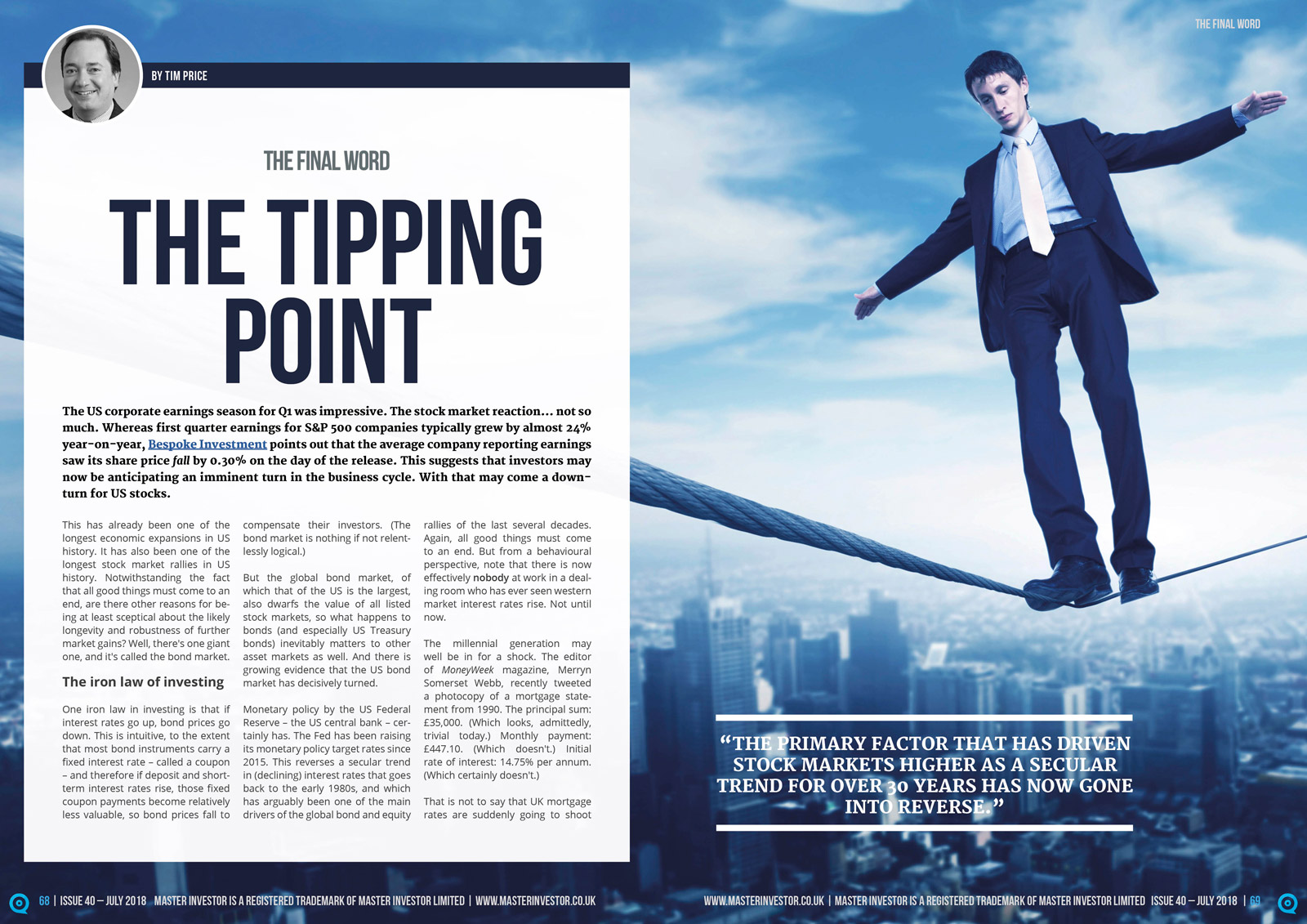Is the business cycle about to turn? – MAGAZINE EXCLUSIVEMAGAZINE EXCLUSIVE

MAGAZINE ARTICLE
This article first appeared in Issue 39 of Master Investor Magazine.
Click here to download the article as a printer-friendly PDF
|
Get this article and many more – for free! |
The US corporate earnings season for Q1 was impressive. The stock market reaction… not so much. Whereas first quarter earnings for S&P 500 companies typically grew by almost 24% year-on-year, Bespoke Investment points out that the average company reporting earnings saw its share price fallby 0.30% on the day of the release. This suggests that investors may now be anticipating an imminent turn in the business cycle. With that may come a downturn for US stocks.
This has already been one of the longest economic expansions in US history. It has also been one of the longest stock market rallies in US history. Notwithstanding the fact that all good things must come to an end, are there other reasons for being at least sceptical about the likely longevity and robustness of further market gains? Well, there’s one giant one, and it’s called the bond market.
The iron law of investing
One iron law in investing is that if interest rates go up, bond prices go down. This is intuitive, to the extent that most bond instruments carry a fixed interest rate – called a coupon – and therefore if deposit and short-term interest rates rise, those fixed coupon payments become relatively less valuable, so bond prices fall to compensate their investors. (The bond market is nothing if not relentlessly logical.)
But the global bond market, of which that of the US is the largest, also dwarfs the value of all listed stock markets, so what happens to bonds (and especially US Treasury bonds) inevitably matters to other asset markets as well. And there is growing evidence that the US bond market has decisively turned.
Monetary policy by the US Federal Reserve – the US central bank – certainly has. The Fed has been raising its monetary policy target rates since 2015. This reverses a secular trend in (declining) interest rates that goes back to the early 1980s, and which has arguably been one of the main drivers of the global bond and equity rallies of the last several decades. Again, all good things must come to an end. But from a behavioural perspective, note that there is now effectively nobody at work in a dealing room who has ever seen western market interest rates rise.Not until now.
The millennial generation may well be in for a shock. The editor of MoneyWeek magazine, Merryn Somerset Webb, recently tweeted a photocopy of a mortgage statement from 1990. The principal sum: £35,000. (Which looks, admittedly, trivial today.) Monthly payment: £447.10. (Which doesn’t.) Initial rate of interest: 14.75% per annum. (Which certainly doesn’t.)
That is not to say that UK mortgage rates are suddenly going to shoot back up into double digits. Rather, investors should be alive to a more insidious prospect – that the primary factor that has driven stock markets higher as a secular trend for over 30 years has now gone into reverse.
The US bond market has noticed. Two-year US Treasury notes, which are acutely sensitive to the direction of policy rates, have seen their yields shoot up from just 0.50% or so, two years ago, to 2.50% or over today. (As bond prices fall, their yields rise.) Much more of this, and the stock market will be forced to respond. It is unlikely to do so in any particularly constructive way. Its main asset competitor – the bond market – has suddenly got dramatically cheaper.
The US earnings season, as already stated, was surprisingly strong. As John Authers for the Financial Times asks:
Just how close are we to the end of the cycle, and how can we know? This question has overshadowed all others in the past few weeks. It explains why stock markets have failed to put in a rally despite historically good earnings in the US. Much hinges on the answer.
With 417 S&P 500 companies now having reported, the picture for the US is unlikely to change much. Even after accounting for tax, the results are very good, and surprisingly so….
To be clear, these were not just good results, but surprisingly good. Wall Street had known about the tax cut for months at the time that it published the final forecasts for the first quarter, and yet the results still came in far better than expected….
Authers speculates that the top of the market cycle could have arrived late in 2017 as President Trump’s tax bill was passed, and US earnings multiples peaked. There is a case that exuberance in the stock market, as demonstrated by high price/earnings (p/e) multiples, put in a high at pretty much exactly the same time as the price of bitcoin did, just before Christmas.
Either way, time, as always, will tell.
House of cards
Other reasons for mild (or not so mild) concern are largely anecdotal. One of them has been the acute focus of market interest in the so-called FAANG family of tech and internet stocks that have driven all else before them. Tesla, admittedly, is not a member of the original FAANGs, but as a high concept glamour stock it is something of a fellow traveller. And in early May we had an object lesson in its owner’s casual disregard for shareholder representation.
Tesla’s Q4 2017 conference call for investors, held on May 3rd, was nothing if not lively. Toni Sacconaghi of the brokerage firm Bernstein had just asked an entirely legitimate question about the company’s capital spending when CEO Elon Musk cut in:
Excuse me. Next. Next. Next. Boring bonehead questions are not cool. Next.
No sooner had another analyst raised a question than Mr Musk interjected again:
We’re going to go to YouTube. Sorry, these questions are so dry. They’re killing me.
The conference call then moved, bizarrely, to some questions from a blogger called Galileo Russell hosted via his YouTube channel.
Unfortunately for Mr Musk, there is a somewhat awkward precedent for his conference call faux pas (which you can listen to, here).
In April 2001, on a conference call for then glamour stock Enron, Richard Grubman of Highfields Capital asked (quite legitimately) why the company was the only financial services business that was unable to provide shareholders with either a balance sheet or a cash flow statement with its earnings. Enron CEO Jeff Skilling replied as follows:
You, you, you… Well, uh… thank you very much. We appreciate it.
Before terminating the call, Skilling made one final vocal outpouring. He called Grubman an a**hole. (You can hear that particular shining gem of public relations here.) Within a matter of months, Enron was bankrupt, and its stock was worthless. Baiting Wall Street analysts may be fun, but it may also highlight that your cash-burning concept business is a house of cards just waiting for its share price to collapse down to its intrinsic value of zero.
But compared to the giant that is the bond market, all tech stocks combined are puny pixies.
The reckoning
One of the reasons our current situation is so precarious is because of that long, effortless bull market in interest rates and inflation. It has conditioned an entire generation of investors, and perhaps more than one, to believe that bonds are safe havens, the perfect complement to a portfolio of otherwise ‘risky’ stocks. But after years of monetary interference from governments and their agents, the central banks, most bond prices have become entirely decoupled from any underlying market reality.
Bonds are, by and large, so outrageously overpriced – and dependent on sustained deflation to justify their current valuations – that they now represent the closest thing we will ever see to return-free risk. This is doubly awkward given the extent to which they form a significant share of the assets held by pension schemes and individual investors. As and when we see a true bond market correction, the outcome for many investors who have outstayed their welcome at the interest rate party will make for a grim reckoning.


Comments (0)